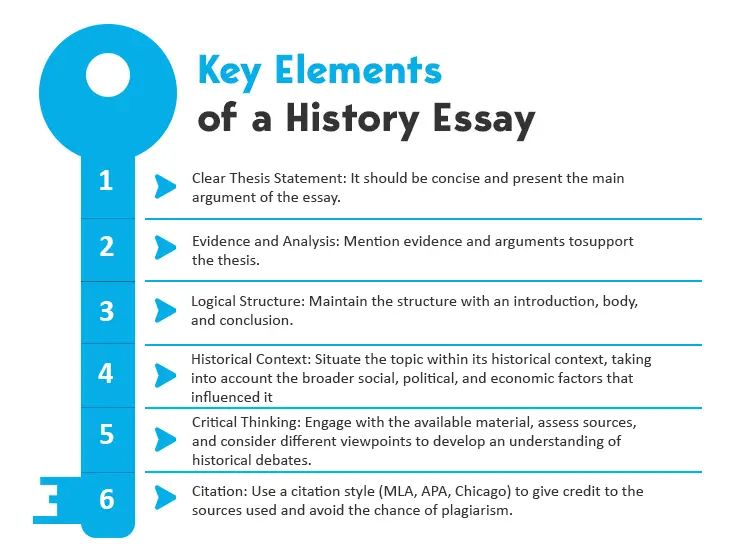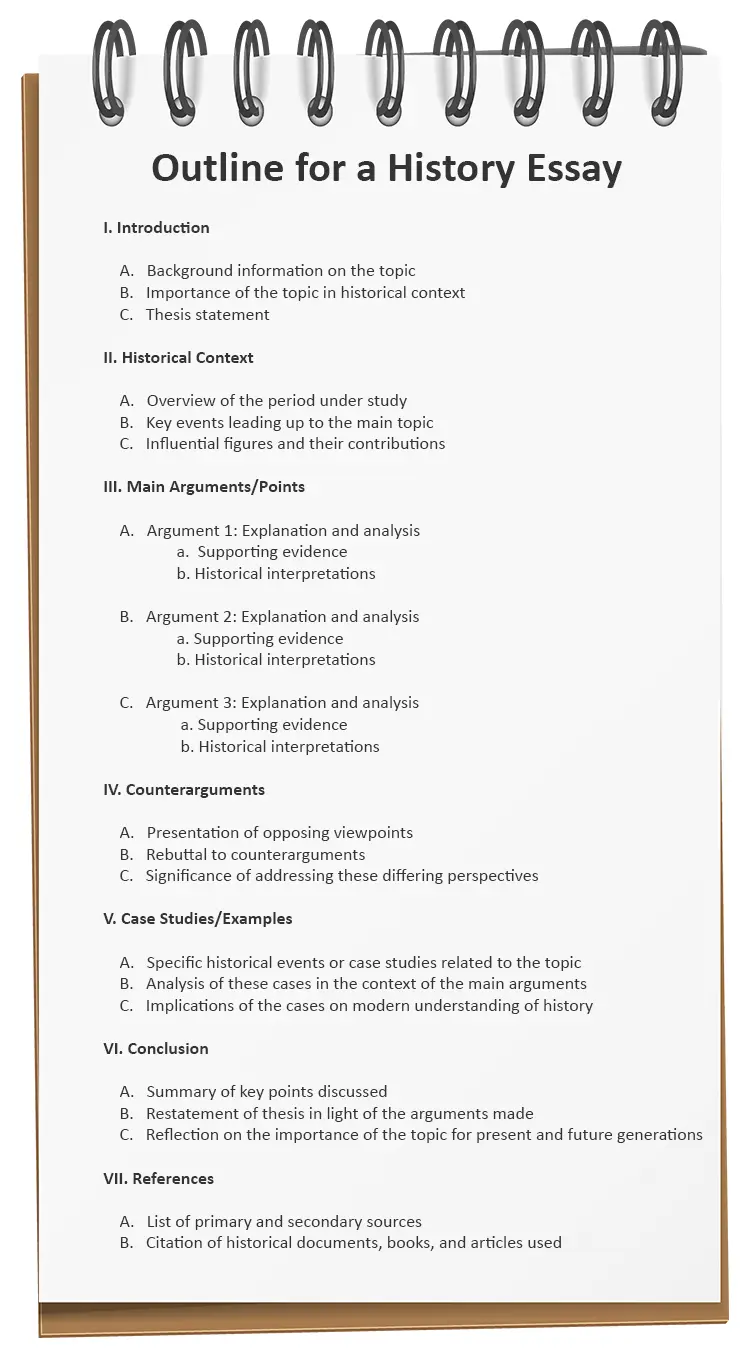27 Proven Tips to Write a Good Essay | StudyUnicorn Guide
Discover 27 expert-backed tips to write a good essay. From planning to polishing, this StudyUnicorn guide helps students improve their writing skills ...
A history essay is an academic paper that investigates the past events, influential leaders, and prominent themes and presents evidence-based arguments to push its analysis. These papers do not only present the facts to the audience but also discuss the consequences, causes, and controversies around an event. The most important part of any successful history essay is a thesis statement, or a brief statement or opinion that informs the reader on how to follow the arguments of the essay.
Various elements, such as a focused thesis, logically structured arguments, and the use of credible primary and secondary sources supporting each of the mentioned points in the essay. Incorporating these points allows the writer to demonstrate analytical thinking and build their credibility.
Many students often ask us how to write a good history essay. We have come up with this comprehensive guide that will take you through the various aspects of the history essay writing process, from writing a compelling thesis to crafting a convincing argument, and ending it with a strong and thoughtful conclusion.
History essay writing involves the critical analysis and interpretation of past events, drawing evidence from primary sources such as speeches, original documents, or artifacts, as well as secondary sources like articles, textbooks, and scholarly works. A history essay not only recounts previous incidents but also presents strong arguments, including various perspectives, and reaches a conclusion.
Such an essay is basic in all educational tasks, whether of high school tasks, IB or A-level tasks, and it remains central at a university scale. By writing a history essay, students develop and portray the most critical skills, which are analytical thinking, research expertise, and the skill of succinctly communicating a complex message. With such essays, they may be included as part of an exam/coursework assessment, and you may be asked to weigh up the evidence, argue about interpretations and express your own attitudes surrounding them.

Writing a good history essay involves historical analysis, a clear and concise thesis statement, and maintaining a proper essay structure, which can often be challenging for students. They frequently ask, “How to write a good history essay?” We understand that the quality of an essay can make or break your credibility among your classmates and teachers, which will ultimately reflect on your report card. While scientific assignment writing relies on data and precision, the humanities focus on interpretation, storytelling, and fact-checking that add quality to history essays. To help you out, we have developed a step-by-step guide to craft a compelling history essay.
Before you begin writing, it is crucial to grasp what the prompt requires. Make sure to carefully read and understand the given instructions so that you can follow the specified guidelines and avoid diverging from the core topic or going off-track. To clarify this further, focus on the following points below:
With a close understanding of each element, you can be well assured that your essay will be focused, complete and exactly what is needed of the given prompt.
A thesis is one of the crucial statements that states the main argument of the essay. To create a strong thesis statement, ensure your statement is focused, arguable, and historically relevant and specific. A strong thesis not only states the event and its facts but also discusses the significance of the event, takes a clear position, and showcases how the writer will support the thesis statement in the essay. For example, instead of making a general claim like ““The French Revolution happened because people were unhappy,” opt for something like: “The French Revolution was primarily driven by economic inequality, as mounting financial crises and burdens on the lower classes led to widespread discontent and demand for change.” This statement:
Revise your thesis as research progresses, ensuring it remains precise, evidence-based, and rooted in the period in question.
The clear analysis adopted in a good history essay is backed with acceptable evidence, and answers particular historical questions logically. The key component of successful essays is the way specific articles are researched with regard to significant primary and secondary sources.
Credible sources for research and evidence in a history essay:
Before you start writing an essay, it is a good idea to first create an outline and then begin writing. Making a blueprint beforehand helps you understand the key points to include and ensures you don't miss any important details.

Half of your writing is done once you have created an outline. The rest of the work involves filling in the outline with evidence, arguments, and words. The writer must structure the essay properly in order to come up with a good history essay by providing a clear, structured essay that brings forth evidence and arguments to support the thesis in each paragraph. Begin by outlining the Title page and the inclusion of an introduction, which subsequently includes the thesis statement that has been formulated into the paper and includes the outline of the main points that will be tackled. This will predispose and make the readers aware of your angle. e.
Talking about a body paragraph now, we are going to suggest starting with separating it into 2-3 smaller paragraphs, each focused on a separate part of the thesis. Every paragraph will have to begin with a point or a particular argument. When you have asserted a point or argument, then it is time to offer an explanation as to why you are offering the given argument and to set the scene. Add primary and secondary evidence to give your essay more credibility. Establish connections with every paragraph so as to be coherent.
In the very end, you are prepared to bring the main argument back and wrap up the closing of your essay. Make the conclusion quite short and do not introduce anything new. Also, in case you have taken quotes, information, or historical data from different sources, you are obliged to provide references to avoid plagiarism.
In order to edit and proofread a history essay, you should concentrate on concise, consistent grammar and correct citation format (e.g., Chicago or MLA). The first step is to read the essay loudly to find awkward phrasings and grammatical issues. Finally, go over the logic of the flow of the paragraphs again and make sure that every paragraph bears concrete evidence as well as analysis to back the thesis. Backward reading can be applied to detect spelling and punctuation mistakes out of context. Make sure that the sources that have been cited have been properly formatted and listed, that paraphrasing and quotes are done with utmost accuracy as per the citation style selected. Note the uniformity of tone, tense, and terms in the whole text. Lastly, take a break in between writing and doing a last review in order to reacquaint your mind with the essay.
These are the ways that would make what has become a good history essay into a nice, well-rounded essay, well-arranged and acceptable intellectual literature on how to write a good history essay.
Writing a strong introduction is the key to the success of a history essay. Many students often ask, “How to write a good history essay introduction?” Use our expert's advice to write a compelling introduction.
An effective essay hook on history makes the reader interested in the history subject and makes them identify easily and strikingly with the history subject. Successful hooks tend to belong to one of the following:
In the introduction, the writer should provide the historical event's background and then articulate the thesis that stems from this background. With the thesis, the author will present the main argument of the essay and outline the key points that will be covered.
Example: In 1789, when the French economy was plunged into a crisis characterized by immense debt and food crisis, there occurred the massive social protest and the French Revolution.
The conclusion is the last part to convince the reader of your argument. And therefore, the role of the conclusion becomes immensely significant. Now, if you wonder “how to write a good conclusion for a history essay,” then use the suggestion below:
The sample introduction that you offered is quite effective indeed since all key elements such as hook, context, and thesis, interact with one another:
By bringing these three elements into an introduction, you can craft a compelling introduction.
These are some of the common problems to avoid that enhance clarity, persuasiveness, and scholarly rigor in history essays.
In order to write good history essays, it is quite possible to find some reliable history essay resources and instruments that can make you a good researcher and provide you with the best writing skills:
To simplify the process of writing:
All these resources and tools can promote the development of specific history essays, which are well-evidenced and cited.
In sum, the knowledge on how to write a good history essay includes quite a number of points to be considered, which will be discussed below: grasping the prompt, creating a focused thesis statement, essay structure, as well as the introductions and conclusions. All of these factors lead to the overall realization of a good story that critically looks at the unfolding of events throughout history.
Using this guide, you will be able to improve on your ability to analyze and develop essays that not only state facts but also explore different views and interpretations. For a personal writing style, explore our guide on personal storytelling in essays for Common App applications.
The above strategies can now be implemented. It is time to write a memorable history essay with the help of our complete guide!
To write a good history essay, focus on presenting arguments with evidence developed from primary or secondary sources, write a clean and concise thesis, and pay attention to the structure of the essay to maintain coherence.
A strong conclusion summarizes the key arguments and main points of the essay without including a new point to provide a final thought on the essay's main topic.
A good introduction grabs the reader's attention with a hook line or a thought-provoking question. Additionally, it includes the historical background and provides a clear and strong thesis.
Some of the common and effective hooks include anecdotes, direct quotes, scenes or illustrations, historical facts and data, or general statements of truth.
Subscribe now!
To our newsletter for latest and best offers